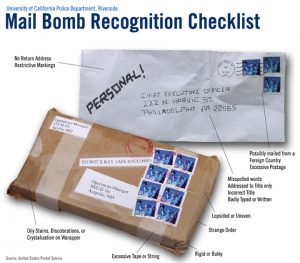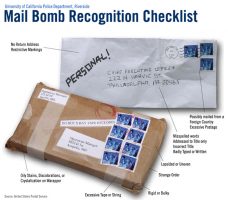
You’re really not likely to come across a letter bomb unless you work in a high-risk environment likely to be targeted by extremists or terrorists or you ticked off a precocious science student. But, as with the random civilian deaths from anthrax, ignorance is always a poor defense.
The United States Postal Service processes over 170 billion pieces of mail every year. The sheer volume of mail makes it impossible for them to screen for bombs. Be aware of indicators that can help you identify a package or letter bomb and the precautions you can take to avoid being injured by such a device.
Look, smell and listen
Although the appearance of mail bombs may vary, here are the characteristics that show up repeatedly:
- Excessive postage. Logically, a bomber will affix too many stamps because he wants to avoid waiting in line with the device and having to talk face-to-face with a mail clerk.
- Indications of the components. Watch for protruding wires, aluminum foil or oily stains. Be wary of sloshing sounds. Mail bombs may emit a peculiar smell of almonds, shoe polish, chlorine, gasoline or nitrogen. Any odd odor is suspect.
- Be wary of packages with an uneven balance of weight.
- Mail bombs may be enclosed in a parcel or an envelope. Keep an eye on both.
- The return address may be vague, nonsensical or there might not be a return address at all. The postmark may indicate a different location than the return address.
- Postal inspectors have found that mail bombs generally target specific individuals. So they may bear restricted endorsements, such as “Personal” or “Private,” designed to make sure a particular addressee opens the package. Restricted endorsements are most likely to be present on bombs sent to people who do not usually receive personal mail at the office. The name may be wrong or misspelled or the package may have the right name, but the wrong job title. They may also bear only the job title and no name.
- Be suspicious of obviously disguised or strange handwriting or if the name and address on the package or letter are prepared with homemade labels or cut-and-paste lettering.
- Parcel bombs may have far more tape than necessary or several combinations of tape. They often carry warnings such as “Fragile–Handle With Care” or “Rush Delivery.”
- Bulkiness. Bombs in letters will contain more than paper, so they will feel hard and inflexible and appear uneven or lopsided.
- Be wary of irregularly shaped packages with soft spots or bulges.
- Biological agents may also be sent through the mail. In addition to the above indicators, watch for letters or packages with any powdery substance on the outside. Do not sniff suspicious packages! Remember microscopic particles can be inhaled easily and absorbed quickly.
What to do:
- Call 911. If you see wires, hear ticking or have any reason to suspect a bomb, evacuate your building.
- Do not open the article. Do not cut any strings, tape or wrappings.
- Isolate the suspicious parcel and evacuate the immediate area.
- Do not submerge the package in water or place it in a confined space, such as a desk drawer or cabinet. Many homemade bombs depend on the mixing of explosive gases, so you should allow the package maximum ventilation. If possible, open windows in the immediate area to assist in venting and to minimize the effect of any concussion caused by detonation, but do not linger to do this.
- Make sure that anyone who has touched the package washes their hands with soap and water. Place items of clothing that have come into contact with the package in plastic bags and give them to the authorities.
- Better safe than sorry. Do not worry about possible embarrassment if the parcel turns out to be innocent. Call 911 and contact the US Postal Inspection Service. Local Postal Inspection Service phone numbers are available at http://www.usps.com/ncsc/locators/find-is.html.

